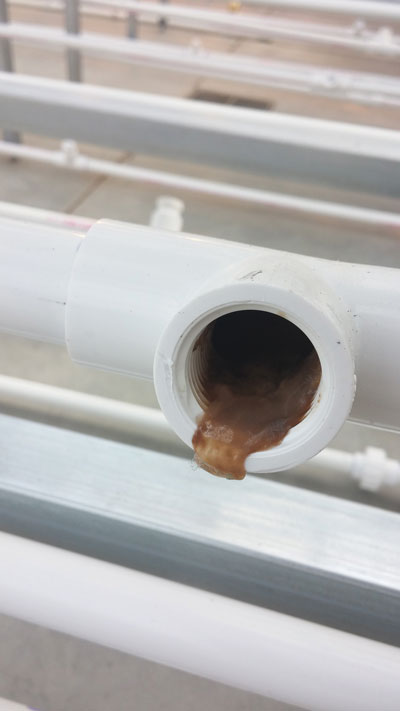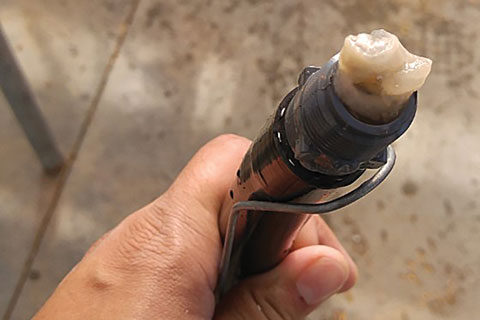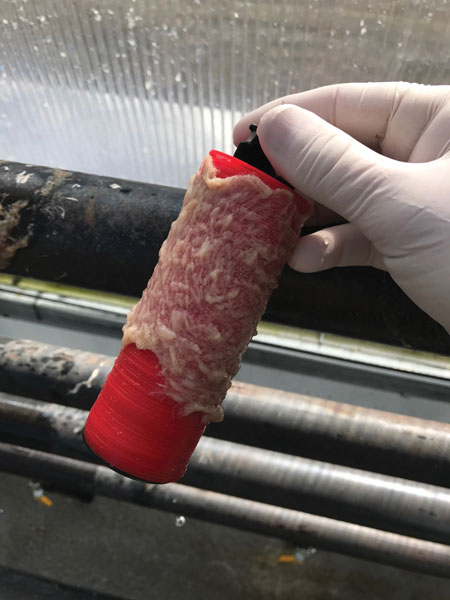1/1/2019
Out of Sight, (Not) Out of Mind
Eric Smith

Everyone knows the old adage. In fact, it’s probably older than the foliage industry itself. “That which is not seen is often forgotten” is a scenario that applies to almost any facet of life. However, in our industry and in plant production, nowhere is it more applicable than your irrigation system. Your irrigation system is indeed the lifeblood of your facility and often one of the most neglected components of the facility.
By neglected, I don’t mean leaky, low pressure, misfiring and/or clogged nozzles, although these can be symptoms of the greater issue. Out of sight, out of mind in this case refers to the native established biofilm that’s very often present in irrigation systems.
Inside the PVC pipes where you cannot see, but through which light can pass, are where we find the favorable conditions for the development of biofilm. Growers who feed with liquid nutrients are most susceptible; the fertilizer is just as effective in growing biofilm as it is growing vascular plants.
This biofilm—a matrix of bacteria, their exudates (polysaccharides) and other pathogens—can wreak silent havoc in your production by clogging/fouling mist nozzles and drip emitters, and in severe cases, restrict flow in lateral lines much like plaque in human arteries. The real issue here, however, is that the biofilm can contain several plant pathogens, which, as the water flows, are sprayed on the crop each time you irrigate. Xanthomonas, Psuedomonas, Pythium/water molds, algae and more can all be found living comfortably in the biofilm matrix.
Pictured: Biofilm inside an irrigation pipe.
Much like a coral reef and fish, the pathogens utilize the polysaccharide matrix as a safe harbor, catching nutrients that flow through to further grow the biofilm. It’s often because of this biofilm that growers have persistent disease issues, despite a litany of spray applications to the crop—they’re re-inoculating with subsequent irrigation events!
Now no longer “out of mind,” how do we combat this hidden scourge of the greenhouse? The answer is two-fold and what we refer to as a “line-shock.” Because of high water hardness, often the biofilm will utilize the available molecules to create a mineral layer—much like a thin shell that protects the polysaccharide inner-working “slime” layer.
 Pictured left: Inside pipes and hoses where you cannot see, but where light can pass, you’ll find the favorable conditions for the development of biofilm.
Pictured left: Inside pipes and hoses where you cannot see, but where light can pass, you’ll find the favorable conditions for the development of biofilm.
To combat this, the first step is to inject an acid (GreenClean Acid Cleaner) into the system at a 1:100 dilution and hold for two to three hours. This will dissolve the mineral layer, exposing the polysaccharide to the kill step. After two to three hours, flush system completely with fresh water. Do not discharge this on to growing plants; use your dump/flush valves or install simple ball valves at strategic locations to drain the system. Failure to first inject the acid cleaner will greatly decrease the effectiveness of the line-shock.
 The second step is to oxidize the polysaccharide layer with a sanitizer/disinfectant, such as SaniDate 5.0. Classified by the CDC as a “high-level disinfectant,” the peracetic acid/hydrogen peroxide combo will destroy aerobic bacteria, algae, yeasts, molds, fungi and their dormant spores for a more thorough kill step. Inject the SaniDate 5.0 at a 1:100 dilution into the system and hold for 12 to 24 hours. This step, like the first, is then flushed out with fresh water preferably through dump/drain valves.
The second step is to oxidize the polysaccharide layer with a sanitizer/disinfectant, such as SaniDate 5.0. Classified by the CDC as a “high-level disinfectant,” the peracetic acid/hydrogen peroxide combo will destroy aerobic bacteria, algae, yeasts, molds, fungi and their dormant spores for a more thorough kill step. Inject the SaniDate 5.0 at a 1:100 dilution into the system and hold for 12 to 24 hours. This step, like the first, is then flushed out with fresh water preferably through dump/drain valves.
The amount of dead biomass that’s now being evacuated from the system requires larger openings. DO NOT try and force it through your mist nozzles/drip emitters. For you nursery folks out there with overhead impact rotors, you can often flush through those due to the larger openings with minimal issue.
Pictured: Biofilm can wreak silent havoc in your production by clogging/fouling mist nozzles and drip emitters, and in severe cases, restrict flow in lateral lines.
(Fun fact! Xanthan Gum, the food/cosmetic thickening agent called “the most superior bio-adhesive” is a polymer exudate of Xanthomonas campestris, the causal pathogen of Black Rot. Think about that for a minute …)
You’ve performed your first line-shock, now what? Bacteria can begin to form new biofilm in a matter of minutes, so it’s extremely important to stay ahead of it. For preventative maintenance, inject a high-level disinfectant (SaniDate 5.0, SaniDate 12.0, ZeroTol 2.0) at very low rates to keep the system clean. Depending on the application and quality of source water, the rate could be anywhere from 1:3,000 to 1:20,000. Water sampling and simple laboratory testing will provide the most cost-effective rate for your application.
With poinsettia season over and spring production soon to begin, take a couple of days in between to focus on sanitation. Foam your walls, cooling pads, benches and floors—just be mindful of the irrigation to ensure “that which is not seen” is no longer forgotten! GT
Eric Smith is the East Coast Turf & Ornamental Manager for BioSafe Systems. He can be reached at esmith@biosafesystems.com.